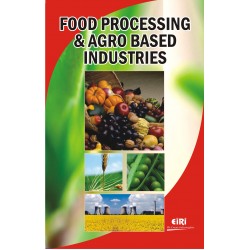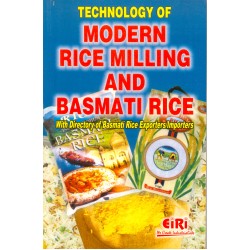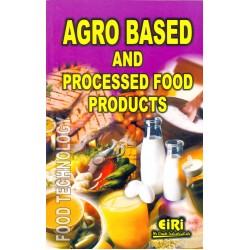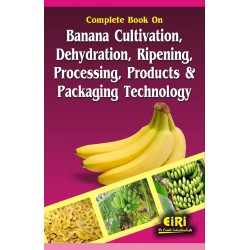hand book of food packaging technology

- More than 40 years of experience
- Managed by expert industrial consultants
- ISO 9001-2015 Certified
- Registered under MSME, UAM No: DL01E0012000
- 24/5 Research Support
Get your quesries resolved from an industry expert. Ask your queries before report or book purchase. - Custom Research Service
Speak to the our consultant to design an exclusive study to serve your research needs. - Quality Assurance
All reports are prepared by highly qualified consultants & verified by a panel of experts. - Information Security
Your personal & confidential information is safe & secure.
HAND BOOK OF FOOD PACKAGING TECHNOLOGY
PACKAGING OF COFFEE, TEA AND SPICES
Introduction
Packaging
Climate and Humidity
Absorption Isotherm
Packaging Materials
Gas barrier Materials
Influence of Humidity
Laminates
Practical Test
Sealing Flexible Materials
Labelling and Graphic Design
PACKAGING OF FROZEN SEA FOODS
Introduction
Packaging (Slip)
Glazing
Primary Warp
Unit Carton
Master Boxes (Corrugated Boxes)
Box Closure
Storage and Warehousing
Quality Control
Containerization
Packlist Costs
Checklist of Sources of Packaging Cost
Package Processing cost
Storage of Filled Packages
Transport of Filled Packages
Cost of Loss and Damage Due to Transport
Insurance Cost
Loss in Sales and Goodwill
Cost Arising from Legal Requirements in Target Markets
Optimum Glazing
Recommended Volume of Block\Unit Carton for Shrimps Based on Standardised Glazing
Guidelines for Primary Warp
Strapping Primary Wrap Eliminating the Need for Unit Cartons
Environmental Legislations
PRESERVATION OF FRESH FOODS
Introduction
Water Content
Ethylene Gas and Carbondioxide
Micro Organisms
Preservation Methods
Refrigration
Freezing
Heating
Aseptic Packaging
Coatings
Modified Atmosphere
Other Methods
Packaging Materials
Conclusion
SHELF LIFE ASSESSMENT OF PROCESSED FOODS
Definition of Shelf life
Product
Package
Environment
Approaches to Shelf Life Determination/Assessment
Traditional Approaches
Storage Tests
Sensory Tests
Newer Approaches
Computer Simulation
Time Temperature Indicators
Response Surface Methodology (RSM)
Kinetics
Steps in Shelf Life Testing
Frozen Pizza
Dehydrated Mashed Potato
Margarine
Pasteurised Milk
OPTIMIZED MAPACKAGING OF FISH FOR RETAILING
Introduction
Vaccum Packaging
Vacuum Skin Packaging
Gas Packaging
Effect of Headspace Volume of the Package
Active Packaging
Comparison of Defferent Packging Techniques
Quality and Safety Aspects of Packaging
Future Prospects
ASEPTIC PACKAGING
Microbiological Aspects of Aseptic Packaging
Sterilization of the Packaging Material Food Contact Surface
The Tetra Classic Aseptic System (TCA)
Sterilization of the Packaging Material Food Contact Surface
Creating and Maintaining a Sterile Surrounding While Forming and Filling the Containers
The Production of Units which are Tight Enough to Prevent Recontamination
Feeding of the Packaging Materials into the filler
The Application of the Hydrogen Perioxide
Forming of the Packaging Material Tube.
The Tube Heater Zone
The TBA/8 And TBA\9 Systems
Sterilization of the Packaging Material Food Contact Surface
Creating and Maintaining a Sterile Surrounding while forming & filling containers
Production of Units which are Tight Enough to Prevent Reinfection
The TBA/10 System
Sterilisation of the Packaging material Food contact surface
Creating and Maintaining a Sterile Surrounding while forming an filling the containers
Production of Units which are Tight Enough to prevent reinfection.
LONG LIFE MILK FROM RAW MILK TO CONSUMER
A Production Line for Long Life Milk Includes the Following Steps and Materials
Raw Milk
Quality Control Activities
Raw Milk Quality and Quantity Improvement Programs
Total Count Determination
Pre-Processing of Raw Milk
The UHT Process
Area
Cleaning
Cleaning Agents
Cleaning Time
Cleaning Temperatures
Velocities
Plan Sterilisation
Process Control
Production Time
Inspection
Maintenance
Aseptic Transfer
Cleaning
Sterilisation
Maintenance
Inspection
Zero Sampling
The Aseptic Filling Operation
Cleaning
Sterilisation
Maintenance
Inspection
Surrounding Environment
Packaging Material Storage, Handing, and Stock Holding
Package Integrity
Sampling of Containers for Incubation
Internal Transport and Handling
Area
Distribution
Area
In-Shop Handling
The Consumer
Area
FLEXIBLE RETORTABLE PACKAGING/ POST PACKAGING PASTEURISATION
METAL CONTAINERS FOR FOOD PACKAGING
Abstract
Introduction
Tinplate Containers
Development in Tinplate Manufacture
Structure of Tincoating
Light Tin Coated Steel (LTS)
Developments in Can Fabrication
Two Piece Cans
Drawn Thin Redraw (DTR) and Precision Sidewall Thickness Control (PSTC) Process
Packaging of Fruit And Vegetable Products in Tinplate Container
Plain Cans
Acid Resistant Lacquered Cans
Sulpher Resistant Lacquered Cans
High Tin Fillet (HTF) Can
Corrosion Problem in Food cans and its Inhibition
Influence of Corrosion Inhibitors
Protective Lacquers
Quality Control Tests
Thickness of Tinplate
Grain Structure of Tincoating
Coating Continuity (porosity) test (ISV)
Tin Oxide
Chromium in Passivation Layer
Special Property Tests
Pickle Lag Test
Alloy Tin Couple Test (ATC)
Physical Tests
Tests for Lacquer
Tincoating
Body
Ends
Tin Grain Size
Iron Solution Value (Porosity)
Tinplate Thickness and Dimensions
Tin Free Steel Cans
Manufacture
Cansuper
Hinac Coat
Hi-Top
Stainless Weirchrome
Fabrication of TFS Cans
Mira Seam
Conweld
Forge Welding
Advantages and Disadvantages of Tin Free Steel
Advantages
Disadvantages
Physical Characteristics of Hi-Top Plate
Surface Film
Corrosion Resistance
Lacquering Quality
Fomability
Weldability and Solderability
Canning Food Products in Tin Free Steel Cans
Fish Products
Meat Products
Fruit and Vegetable Products
Aluminium Containers
Advantages
Disadvantages
Package Forms
Conventional Three Piece Can
Drawn Cans
Impact Extruded Cans
Drawn And Redrawn Cans (DRD)
Aluminium Closures and Ends
Conventional Closures
Easy Open Ends
Easy Open Ends are of Two types
Packaging of Food Products in Aluminium Cans
Fruit and Vegetable Products
Lacquered Cans
Meat Products
Marine Products
Milk Products
Alcoholic Drinks
Corrosion in Aluminium Cans
External Decoration and Printing
Future Scope
Evaluation of Indigenous Electrolytic Tinplate
Correlation of Physico Chemical Characteristics of Indigenous Tinplate with the Shelf life of the Canned
products
Assessment of Differential Tinplate
Evaluation of Indigenous Aluminium Cans for processed Foods
CARTON BOARD, FOLDING CARTONS FOR FOOD PACKAGING
Introduction
To Pack with Folding Boxes
Packaging by Head (Manual Packaging)
Packaging and Filling Migration and Sensoric
Recycled Fibers for Food Packaging
Microbiological Tests
Sensoric Tests
Migration Tests
The folding Carton Market and its Developments
The European Folding Carton Market
Recent Developments within the packaging industry
Roduction Process in the folding carton industry
Printing and Varnishing
Die-Cutting and Creasing
Gluing and sealing
Defferent Kinds of Folding Carton Boxes
Special R & D Efforts for the Food Packaging Industry
Needs of the Industry
Barrier Boards
Tight Packs
Total Packaging Cost Analysis
Special Development Projects
Formastar
Foldpak
THERMOFORMED AND BLOW MOULDED CONTAINERS FOR FOOD PACKAGING APPLICATIONS
Introduction
Low Density and linear Low Density Polyethylene
High Density Polythylene
HDPE Food Packaging Applications
Polypropylene
PP Food Packaging Applications
Polystyrene
Polystyrene Food Packaging Applications
Polyvinylchloride (PVC)
PVC Food Packaging Applications
Polythylene Terephthalate (PET)
PET Food Packaging Applications
Two Layered Sheets
Conclusion
BLOW MOULDED CONTAINERS FOR FOOD PACKAGING
Basic process Concepts
Technology Development for Food Packaging
Aseptic Containers
Barrier Containers
PET Containers
Newer Developments
Blow Moulding Machine Meets Diverse Production Needs
Core Rod Technology
Container Design
Pen(Polythlene Naphthalate )
Screw Design
Multilayer Perform
Polycarbonate
Conclusion
Abbereviation
JUMBO BAGS FOR FOOD AND TEA
Introduction
Genesis of Bulk Packaging System
Food and Food Products
For Sugar and Coffee
Cocoa Beans
New Usage
Results of the Trial
Unloading
Moisture Contents
Volume cc\125g
Tea Quality and Value
Filled Weight
Filling Big Bags in Kenya
Big Bag Trial
Moisture Contents
Recommendations for Future Trials
Conclusion
PACKAGING OF FISH
Abstract
Introduction
Important Quality Aspects of Fresh Fish
Introduction
Bacteria and Enzymes
Contamination
Physical Damage
Oxidation
Dehydration
Factors Influencing
Spoilage
Biochemicals Decay
Spoilage Bacteria
Pathogenic Bacteria
Conclusion
Packaging Concepts
Introduction
Aftering Gas Conditions
Vacuum Packaging
Introduction
Shelf Life
Modified Atmosphere Packaging
Introduction
Packaging Process
Bacterial Growth
Gas Mixtures
Shelf Life
Carbon Dioxide Levels
PACKAGING OF VALUE ADDED FISH PRODUCTS
Individully Quick Frozen (IQF) Shrimp
Battered and Breaded Products
Surimi
Fish Sausage
Fish in Sauce and Fish Salads
Accelerated Freeze Dried (AFD) Products
Fish Pickles
Modified Atmosphere Packaging (MAP)
Fish Curry
Fish Soup Powder
Dry Fish Pickle
Sharkfin Rays
Chitin\Chitosan
PACKAGING OF MILK AND MILK PRODUCTS IN INDIA
Liquid Milk
Concentrated Milks
Milk Powder
ICE Creams
Butter
Ghee
Cheese
Indigenous Milk Products
PACKAGING OF CEREALS AND CEREAL PRODUCTS
Spoilage Factors
Whole Grains & Split Pulses
Jute Bags
Advantages of Jute Bags and Jute Fabrics
High Mechanical Strength
Soft Surface with High Resistance to Friction
Porous Structure
Disadvantages of Jute Bags
Availability
Mineral Oil Contamination
Insect Breeding
Cost
High Density Polyethylene (HDPE) Polypropylene (PP) Woven Sacks
Manufacturing Process of HDPE Woven Sacks
Extrusion of Slit Film
Looming
Lamination
Cutting
Stitching
Printing
Bale Pressing and Packing
Advantages of HDPE & PP Woven Sacks
Disadvantages of HDPE & PP Woven Sacks
Quality Parameters to be Considered for Woven Sacks
Denier
Mesh Count
Weight Of the Bag
Pigment Content
UV Stabilisers
Antislip Agent
Breaking Load
Consumer Packs for Whole Food Grains
Miled Grain Products (Flours)
Bulk Packs
Consumer Packs
Polythylene Film
Linear Low Density Polyethylene (LLDPE)
High Molecular High Density Polythylene (HMHDPE)
Co-Extruded Films
Polypropylene (PP)
Density
High Transparency
Cost
Biaxially Oriented Polypropylene Film (BOPP)
Laminates
Processed Cereal and Pulse Products
Cereal Based Convenience Foods
Cereal and Pulse Based Mixes such as Vada, idli, dosa
Ready Mixes Like Cake Mix Having High Fat Content are
Cereal and Pulse Mixes Containing Spices
Weaning Foods
PACKAGING OF MALTED MILK FOODS
Introduction
Present Packaging System
Glass Containers
Variant
Advantages
Disadvantages
Modality of Usage
Pet Containers
Varient
Advantages
Disadvantages
Modality of Usage
Flexible Packaging Materials
Varient
Browns (Malted Milk Food)
Whites (Malted Milk Food)
Nutritional health Beverage
Advantages
Disadvantages
Modality of usage
Significance of Packaging on FFS
Functional Requirement
PACKAGING FOR BISCUITS
Protection Presentation, Information and Convnience
The Wrapping Materials
The Packaging Styles
Endfold Wrapping
Pillow Pack Wrapping
The Old Size Biscuits
The production Preparation Stage
Manual Feeding
Semi Automatic Feeding
Fully-Automatic Feeding/Wrapping
Pick and Place Units or Robot Loading Cells
PACKAGING OF EDIBLE OILS, VANASPATI AND GHEE
Introduction
Fatty Acid Composition of Oil and Fats
Spoilage Factors
Distribution Pattern
Packaging Systems/Types of Pack
Package Types
Tinplate Containers
Glass Bottles
Semi Rigid Containers
HDPE (High Density Polyethylene) Containers
PET (Polyethylene Terephthalate) Bottles
PVC (Poly Vinyl Chloride) Bottles
Other Semi rigid Packs
Flexible Pouches
The Other Relevant Indian Standards are
Analysis of Needs and Shifts
Structures and Critical Polymers
Structures
Critical Polymers
Nylon-6
Tie Layer
Polyester
A Closer Look
Flexibles as Economical Media
Flexibles as Effective Solid Waste Reducing Media
Indian Standard for Packaging of Edible oils, Vanaspati and Ghee
Legislations
Conclusion
TRENDS IN PACKAGING OF SPICES AND SPICE PRODUCTS
Packaging of Ground Spices
The Important Findings of the Study are as follows
Bulk Packaging and Storage of Whole Spices
Packaging of Oleoresins and Volatile Oils
Insect infestain and Fumigation
Literature Data on Packaging
future Trends
PACKAGING OF CASHEW NUTS
Introduction
Packaging System
Specification of Tinplate Containers
Specification for CFB Box
Recent Developments
Alternate Packaging Systems
Bag-in-Box (Flexible) System
Bag in-Box (Semirigid System)
Consumer Packs
Conclusion
PACKAGING OF SNACK FOODS
Introduction
The Product Group
Packaging Materials for Snack Foods
Packaging Systems
Gas Flushing
Compensated Vacuum
Conclusion
TRENDS IN PACKAGING OF CARBONATED AND STILL BEVERAGES
Introduction
Glass Bottles
Plastic Bottles
Bottling System
Bottle Washing
Bottle Filling
Bottle Crowing or Bottle Capping
Aluminium Cans
Non-Carbonated Beverages/Still Drinks
Aseptic Packaging System (Tetrapak)
Plastic Bottles
Plastic Closures
Why Plastic Closures Prevail?
Purpose of Hot Filling
Flexible Pouches
Retortable Pouches
Bag-in-Box System
Bags
Containers
Fillers
TRENDS IN LIQUOR PACKAGING
Introduction
Global Trends
Why Packaging
Secondary Factors Are:
Glass Bottles
Glass Bottle Palletisation
PET (Polyethylene Terephthalate) Bottles
Closures
Printing and Associated Decoration Technologies
Labels
Monocartons
Tampo Printing
Master Cartons
Bottling Equipments
Conclusion
REQUIREMENTS FOR PRESERVATION, STORAGE, DISTRIBUTION AND TRANSPORTATION OF
FRESH FRUITS AND VEGETABLES
The Result of Low Temperature Storage is Extension of Shelf Life
Storage Conditions
Transpiration
Precooling
After Harvest Chill Storage
During Shipment as Refrigerated Cargo
Freezing Injury
Chilling Injury
Strage Requirements
Maintaining Uniform Recommended Temperature in Perishable Commodities Retards
Respiration
Transporation for Export
Storage of Fresh Fruits and Vegetables
Control of Deterioration and Diseases
Citrus Fruits
Deciduous Fruits
Other Fruits
Vegetables
ECOFRIENDLY AND SAFE PACKAGING OF SEA FOODS FOR EXPORTS
Introduction
Health and Safety Risks
Health and Safety Regulations
Marking and Labelling
Environment
Environmental Regulations
PACKAGING IN THE CONFECTIONERY INDUSTRY
The Purpose of a Package
The Container
Materials
Metal Cans
Paper and Associated Materials
Manufacture
Types of Paper
Unbleached Kraft
Bleached Sulfite Papers
Glassine and Greaseproof (G&G) Papers
Vegetable Parchment
Waxed Paper
Tissue Paper
Carton Board Paper Board
Metal Foil
Gauge
Porosity
Printing
Foil Containers
Transparent Film
Polythene (Polyethlene)
Polypropylene Film
Metallised Films
Shrink and Stretch Films
Laminates
Selection and use of Materals for Chocolate and Confectionery
The Machinery
The Type of Wrap
Parcel Wrap
Bias or Oblique Overlap
Sleeve Wrap
Twist Wrap
Bag and Pouch (Pillow) Wraps
Roll and stick wraps
Heal seal wraps
Bunch fold wraps
Vacuum and Gas Packaging in Flexible Materials
Vacuum Forming
Other Forms of Wrap
Physical Properties of Wrapping Materials Testing Methods
Strength
Tensile Test
Impact
Tear Strength
Bursting Strength
Permeability
Gas Permeability
Water Vapor Permeability
Water Activity
Physical structure
Water and Gas permeability of Various Packaging Materials
Printing Odors in Food Wrappers
Prevention of Odor
Removal of Odor
Testing Wrappers for Printing Ink Odor
Bottle Test 1
Bottle test 2
Gas Chromatograph
Testing of Wrappers for Various Other Properties
Determination of water vapour Permeability
Creasing Test
Crumpling Test
Testing the Effeciency of Heat Sealing on a Wrapped Confectionery
Resistance of Printing Ink and Varnish to Tropical Conditions
Effect of Liquid Fats
Grease Staining Test
Tropical Test for Determinining the Adhesion of Printed or Varnished Surfaces of Wrappers
Toxicity
Prining
Toxicity Standards
Wrapping Materials in Display and Advertising
Testing of wrapping and Advertising Materials for Fading
Adhesives
Odour
Discoloration
Storage
Physical Properties of Adhesives
Adhesive Groups
Vegetables Adhesives
Starch Adhesives
Vegetable Mucilage
Animal Glues
Solid
Jelly
Liquid
Synthetic Resin Adhesives
Sodium Silicate
Bitumen
Microcrystalline Waxes Rosin, Mineral Jelly Mixtures
Rubber Solution and Latex
Mechanical Sealing Methods
Bar Sealing
Impulse Sealing
Hot Wire, Knife Sealing
Other Methods
Adhesive Tapes
Gummed Paper Tape and Cotton Fabric Tape
Self Adhesive Tapes
Strength
Storage of Reels of Tape
Water Vapor Permeability
The Application of Adhesive Tapes
Metal Containers
Types of Cans
Built up Body
Seamless Body
Vacuum Sealing
Gas Packing
Dessicant Pouches
RETORTABLE POUCHES
Retort Pouches Products
Quality and shelf life
Advantages of Retortable Pouches Compared to Metal Cans
Disadvantages
POST HARVEST TECHNOLOGIES AND PACKAGES OF BANANA FOR EXPORT MARKETING
PreHarvest Practices to Obtain Quality Banana
Post Harvest Package of Technologies
Selection of Banana
Harvest Maturity
Harvesting and Handling
Packing of Hands
Post Harvest Treatments
Method of Packing
Pre-cooling
Method of Storage
Loading into container
Management in the container
Post Transportation Care/Ripening
BIODEGRADABLE PACKAGING FOR FOOD INDUSTRY
Traditional Plastics
Biodegradable Materials
Startch Based Materials
Themoplastic Starch Composites
Cellulose Based Materials
Chitin/Chitosan
Pullulan
Casein
Whey
Zein
Polylactic Acid (PLA)
Poly (Hydroxy Alkanoates) (PHAs)
Polycaprolactones
Polyvinyl Alcohol (PVOH)
Application for Food Industry
Conclusion
Engineers India Research Institute (EIRI) is a renowned name in the industrial world for offering technical
and financial consultancy services.
EIRI services are:
Detailed Feasibility Reports
New Project Identification
Project Feasibility and Market Study
Identification of Lucrative Industrial Project Opportunities
Preparation of Project Profiles / Pre-Investment and Detailed Feasibility Studies,
Market Surveys / Studies, Market Survey Cum Detailed Techno-Economic Feasibility Reports
Project Reports in CD Roms
Identification of Plant /Process/Machinery and Equipment, Industrial General Guidance for setting up new
industrial projects.
Our most up-to-date and Technologically Advanced Industrial Project Reports, categorized with respect to
Financial Outlays and Sector – wise Classification are immensely useful for :
Existing Small or Medium Scale Industrialists facing competition from large houses
Young Entrepreneurs dreaming to start their own industrial enterprise
Young Graduates and Professionals wishing to begin their career
Industrialists interested in Debottlenecking their capacities & New Product – Lines
Large Industrial Houses pursuing Expansion, Growth and Diversification Plans
How to Make Project Report?
Detailed Project Report (DPR) includes Present Market Position and Expected Future Demand, Technology, Manufacturing Process, Investment Opportunity, Plant Economics and Project Financials. comprehensive analysis from industry covering detailed reporting and evaluates the position of the industry by providing insights to the SWOT analysis of the industry.
Each report include Plant Capacity, requirement of Land & Building, Plant & Machinery, Flow Sheet Diagram, Raw Materials detail with suppliers list, Total Capital Investment along with detailed calculation on Rate of Return, Break-Even Analysis and Profitability Analysis. The report also provides a birds eye view of the global industry with details on projected market size and then progresses to evaluate the industry in detail.
We can prepare detailed project report on any industry as per your requirement.
We can also modify the project capacity and project cost as per your requirement. If you are planning to start a business, contact us today.
Detailed Project Report (DPR) gives you access to decisive data such as:
- Market growth drivers
- Factors limiting market growth
- Current market trends
- Market structure
- Key highlights
Overview of key market forces propelling and restraining market growth:
- Up-to-date analyses of market trends and technological improvements
- Pin-point analyses of market competition dynamics to offer you a competitive edge major competitors
- An array of graphics, BEP analysis of major industry segments
- Detailed analyses of industry trends
- A well-defined technological growth with an impact-analysis
- A clear understanding of the competitive landscape and key product segments
Need Customized Project Report?
- Ask for FREE project related details with our consultant/industry expert.
- Share your specific research requirements for customized project report.
- Request for due diligence and consumer centric studies.
- Still haven't found what you're looking for? Speak to our Custom Research Team
About Engineers India Research Institute:
Note: We can also prepare project report on any subject based on your requirement and country. If you need, we can modify the project capacity and project cost based on your requirement.
Our Clients

Our Approach
- Our research reports comprehensively cover Indian markets (can be modified as per your country), present investigation, standpoint and gauge for a time of five years*.
- The market conjectures are produced on the premise of optional research and are cross-accepted through associations with the business players
- We use dependable wellsprings of data and databases. What's more, data from such sources is handled by us and incorporated into the report
Why buy EIRI reports?
- Our project reports include detailed analysis that help to get industry Present Market Position and Expected Future Demand.
- Offer real analysis driving variables for the business and most recent business sector patterns in the business
- This report comprehends the present status of the business by clarifying a complete SWOT examination and investigation of the interest supply circumstance
- Report gives investigation and top to bottom money related correlation of real players/competitors
- The report gives gauges of key parameters which foresees the business execution
























-250x250h.jpg)














